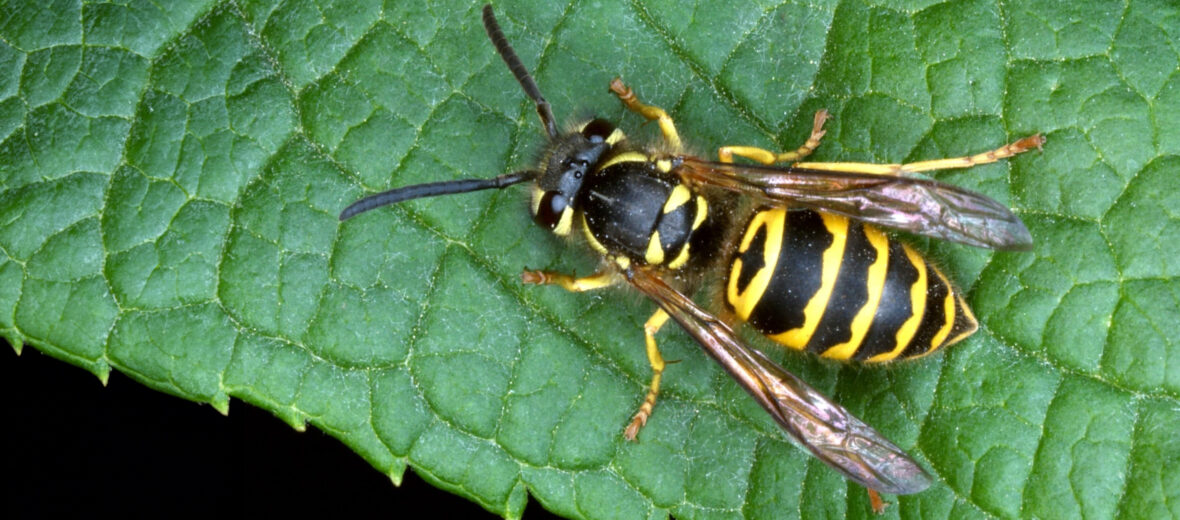
The yellowjacket, aka yellow jacket, is a predatory but social wasp species native to the United States and Canada. They are often confused with paper wasps and hornets. These insects are typically identified by their tell-tale yellow and black (sometimes white and black) markings, their presence only in colonies, and a characteristic, quick, side-to-side flight pattern just before landing. Due in part to their abundant population these critters are not listed with the IUCN.
First the Stats…
Scientific name: Vespula vulgaris
Length: Up to .625 inch, queens are up to .78 inch
Lifespan: Up to 22 days, queens live up to 1 year
Now on to the Facts!
1.) All the females in a colony are capable of stinging repeatedly. Males are not capable of stinging though.
2.) Yellowjackets are considered important by farmers in controlling pest insects.
3.) These critters have lance-like stingers that possess small barbs, and usually sting repeatedly, when threatened.
4.) They have well-developed and powerful mandibles (jaws) meant for capturing and chewing insects.
5.) Not only do they have mandibles, but they also have a probosces for sucking fruit, nectar, and other juices.
But wait, there’s more on the yellowjacket!
6.) Nests are constructed of chewed wood pulp inside trees, shrubs, inside man-made structures, in holes in the soil, tree stumps, mouse burrows, and more.
7.) Hornets are their closest relative, but are differentiated by larger heads and eyes, plus hornets can be far more aggressive.
Did you know…?
The effects of a yellowjacket’s venom are redness, swelling, itching, hives, pain, wheezing, nausea, fainting, and vomiting. Anaphylaxis (shock) and even death may occur in rare cases concerning an allergic reaction to the venom. But death only occurs in very rare circumstances involving allergies and mass stinging events.
8.) Only inseminated queens overwinter. The rest of the hive dies when the temperatures drop too low.
9.) Queens emerge during late spring or early summer, find a nest site, and construct a small paper nest. Eggs are laid in the nest and are cared for by the queen until they pupate and develop into infertile workers.
10.) By midsummer, the first of the adult workers are ready to take on the tasks of nest growth, looking for food, care of the queen & larvae, and defending the colony.
But wait, there’s still more on the yellowjacket!
11.) Until autumn, when she dies, the queen stays inside the nest laying eggs.
12.) The nest expands rapidly to around 5,000 workers and a nest size of up to 15,000 cells by late summer.
Did you know…?
In a form of trophallaxis (the transfer of food or fluids to other members of a community) the larvae excrete a sugary substance called honeydew for the workers to consume.
13.) Southern colonies tend to be much larger than northern ones and house dozens of queens, over 10,000 workers, and over 100,000 cells!
14.) After leaving the hive to mate, males soon die, while fertilized queens look for protected places to overwinter.
15.) As soon as the males and newly produced queens leave the nest, the parent colony workers begin to die, usually leaving the nest to wither. The founding queen also perishes at this time.
But wait, there’s still a little more on the yellowjacket!
16.) Adults feed on sugars and carbohydrates, like flower nectar, fruits, and tree sap. The larvae feed on proteins obtained from insects, meats, and even fish.
17.) Most of the insects collected by workers for the larvae are considered to be agricultural pests.
18.) By late summer, larvae are producing less for workers to eat. The foraging workers look for sources of sugar outside the nest such as ripe fruits and human garbage.
Now a Short Yellowjacket Video!
Be sure to share & comment below! Also, check out the Critter Science YouTube channel. Videos added regularly!
Want to suggest a critter for me to write about? Let me know here.
Some source material acquired from: Wikipedia & IUCN



